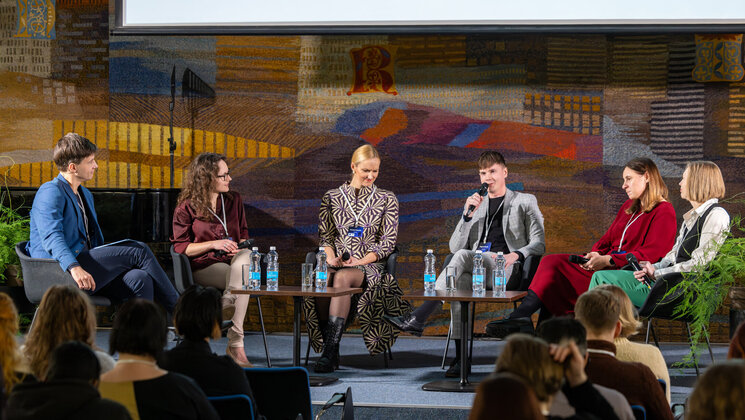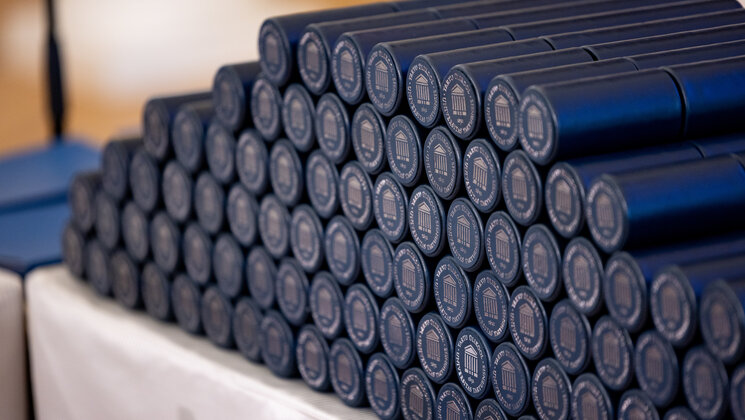Rector: the world of values grounded on university education is the strongest and the most durable shield

Rector Toomas Asser's speech at the ceremony dedicated to the royal couple of Sweden in the University of Tartu assembly hall on 4 May 2023.
Your Majesties! Honoured guests!
In this assembly hall, the first minister of education of the young Republic of Estonia and the Curator of the University of Tartu Peeter Põld opened our Estonian-language University of Tartu on 1 December 1919. That was a political poiesis, an act validating a small country but a big idea and culture. That inauguration laid the foundation to Estonian-language higher education based on top-level international science. An international national university was established, the one we are holding today. For the first time, the highest educational institution belonged to Estonians and catered for our needs while continuing research and teaching at a highest international standard. By now, the university has been operating like that for one hundred and four years.
The University of Tartu builds on the legacy of Gustav Adolf, and his idea to govern the provinces on the eastern coast of the Baltic Sea through smart and educated people. In 1632, Gustav II Adolf signed the decree of founding Academia Dorpatensis. He did so on the recommendation of Johan Skytte, the state counsellor, the chancellor of Uppsala University, and the appointed Governor General of Livonia, Ingria and Karelia. The University of Tartu was the second-oldest university in the Kingdom of Sweden, after Uppsala and before the Turku/Åbo Akademi.
The founding of the university was not random – it was enlightened emancipation. The promotion of education was not limited to the university, but also a system of public schools was introduced to educate Lutheran pastors and school teachers and to spread literacy. In 1684, a Swedish pastor’s son Bengt Gottfried Forselius established a teachers’ seminary on the outskirts of Tartu. Compared to other approaches of the time, it was a far more forward-looking and innovative way of governance. Indeed, Estonia, Latvia, Lithuania and Finland – which Swedish 20th century geographer Sten De Geer and the professor of economic geography of the University of Tartu Edgar Kant called the Baltoscandia, along with the Scandinavian countries – were lucky. Estonia desired to use the idea of Baltoscandia to emphasize our inclusion in the Scandinavian culture and thereby identify itself with Nordic values. It proved successful. Although a small nation, we have well-functioning higher education, an active language and intellectual life, vibrant economy, and close overseas relations. Many large nations do not have a native-language university or independent statehood. This unfortunate correlation gives food for thought. We are proud and happy that it is different here. Our folklore remembers the good old Swedish times as a golden era. A fine example are some one hundred or so old trees still growing here. According to our legends, half of those were planted by Karl XII, who, so the legend implies, probably had a spade on his hip instead of a sword.
Unfortunately, the Great Northern War cut through the Swedish-Estonian ties, and the people were thrown into the darkness of serfdom. The Muscovites bombed Tartu to the ground in 1704, the kind of destruction they and other foreign powers have repeated throughout history. As poet Viivi Luik writes in her novel The Beauty of History, which is also available in Swedish: In the dead silence of the night, countries and people are moving from West to East, so that not even a dog barks. 24 February 2022 made it clear that we are once again faced with the need to protect the border between West and East, the light and the darkness.
Since Estonia became independent in 1918, we have fulfilled that mission and consistently broken “the dead silence of the night”. Estonia has remained a realist, identifying threats from the East and disrupting the comfortable state of oblivion in the West. Today, the West has woken up. Four hundred years after the university was founded and 105 years after the independent state of Estonia was established, we stand side by side as European Union and NATO allies, rigid and vigorous in defence of our values on the eastern border. The world of values grounded on university education is the strongest and the most durable shield.
Estonia is grateful to Sweden. For the free Estonian Coastal Swedes. For help in rebuilding our state. For accepting Estonian refugees of war and supporting their free cultural life. We can well remember that, for example, in the 1950s, more Estonian literature was published in Sweden than in Estonia. Well, the Estonian diaspora also gave Sweden something in return. After all, the poet Ilmar Laaban is considered an important promoter of surrealism in Sweden. Or, maybe you have heard the symphonies by Eduard Tubin, who lived in Stockholm? Perhaps Ilon Wikland’s illustrations have helped expand your imagination. Now it is our turn to support the Ukrainian refugees waiting for our protection and the Ukrainian state defending its independence. It is an honour to do it together with Sweden. As allies.
The University of Tartu stands on a solid foundation. We have risen to rank among the world’s top 250 universities and are fast approaching our partners in Sweden and elsewhere. We are among the top 1% of the world’s most cited universities. Our work and activities are closely intertwined with international research centres. Our researchers regularly work in the laboratories and with the research groups of Uppsala, Karolinska, KTH, Malmö, Lund, Stockholm and other Swedish universities. Swedish colleagues often visit our university. We are making joint efforts to push the frontiers of knowledge in all critical areas of life, including but not limited to biodiversity, climate and sustainable development, and also health, population and technology, IT and AI.
Besides this role, Tartu also needs to assure that the intrests of Estonian state and society are served and that our language and culture – our way of life – survive. One hallmark of this role is the University of Tartu’s presence in Narva with its college, just 350 metres from the border of the Russian Federation, symbolically standing for education, culture and Western values, and against the irrational, dead-end empire of power on the opposite bank of the Narva river. Our university ensures that the State of Estonia and Europe have the necessary resources to keep this border permanently. This task was engraved to our DNA in 1632 by King Gustav II Adolf of Sweden, and this border has survived over time. It is our task to make sure that this old, jointly established boarder stands and that our values will survive for the next 400 and more years.
Long live the national research university!
Long live the partnership between Sweden and Estonia!
Vivat! Crescat! Floreat!
Find more to read:
- King Carl XVI Gustaf and Queen Silvia of Sweden visited the university
- Rector Toomas Asser and Professor Raul Eamets received the Swedish Royal Order of the Polar Star
- Business delegation accompanying the Swedish royal couple were shown the UT's influential teaching and research areas and health technology






